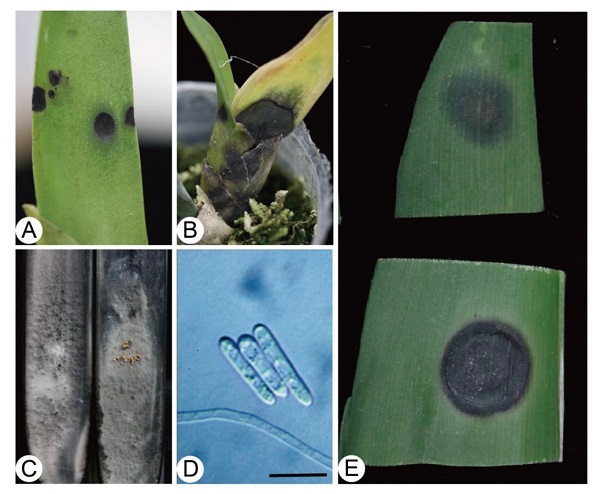All issues
Author:Jiunn-Feng Su, Pei-Hung Lai, Lan-Yi Chien, Jin-Hsin Huang, Tsung-Chun Lin, and Ting-Fang Hsieh*
Abstract:
The field surveys were conducted at Puli Township, Nantou County in February and July 2012. Both of the oncidium cultivars Alba (Psychopsis kalihii, ‘Green Valley’) and‘Mountain’ (Psych. mariposa) showed black spot with circular to irregular on leaves and sheath parts of diseased plants. The disease incidences were up to 42–63% in field surveys. The colony characteristics of fungi isolates from diseased plants showed gray to dark color with abundant pinkish conidia mass on 1/2 sucrose of potato dextrose agar. The conidia are cylindrical with the size ranges of 2–2.5 μm × 9.9–22.3 μm. After following Koch’s postulates to make sure the pathogenicity, two isolates of TJP-1537-2 and TJP-1537-4 were chosen and submitted for further molecular identification by using sequence comparison of internal transcribed spacer (ITS) of ribosomal DNA. The pathogen causing the new recorded Psychopsis anthracnose was identified as Colletotrichum orchidophilum Damm, Cannon & Crous. Optimum temperatures for mycelial growth of pathogen ranged from 20 to 24℃, and the growth rates ranged from 5.1 to 5.6 mm day-1. Optimum temperatures for disease development ranged from 16 to 28℃.
Key words:Psychopsis, Colletotrichum orchidophilum, anthracnosec
Download:![]() PDF Links
PDF Links
- 1. Development of Tractor-Mounted Seedling Transplanter for Sweet Potato
- 2. Synergistic Effect of Additional Gas on the Toxicity of Phosphine to Sitophilus oryzae and Sitophilus zeamais (Coleoptera: Dryophthoridae)
- 3. Effects of Temperature and Solar Radiation on Growth Traits and Plant Elements in Purple Leafy Sweet Potato

 Submit your manuscript
Submit your manuscript
 Guide for authors
Guide for authors